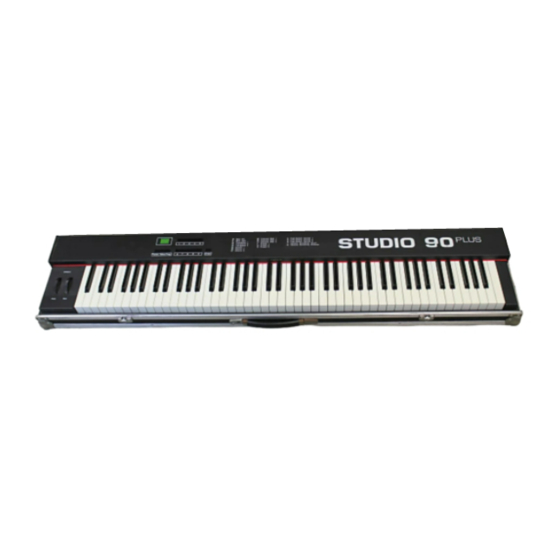
Advertisement
Thank you for purchasing the FATAR Studio-90 Plus, the finest feeling master controller on the
market today. The action is a result of many years of engineering that went into the keyboard
mechanism. There are actually hammers that strike a surface that simulates a piano string.
The FATAR Studio-90 Plus master controller is very simple to operate once you understand its
capabilities. Even though the controller seems to be always in split mode, you can layer or split
one, two, or three sounds across the entire length of the keyboard. However, you must be aware of
the specific use of each parameter to get the desired results.
FEATURE LIST! The following is a feature list of the ST-90 Plus master keyboard controller.
- Power Supply: 9 VDC 500mA
- 88 Note Weighted Hammer Action Keys
- Key measurements like a real piano
- Dynamic Range (00-99)
- Velocity Sensitivity Release (00-99)
- Three Zones Programmable
- Half-tone transposition
- Octave transposition
- Three MIDI Outputs
- Foot-Switch Control
- Program Change Footswitch
- Pitch and Modulation Wheels
- Outputs on all l6 MIDI Channels (three channels at one time)
- 100 Performance Programs (00-99)
- Two digit numeric display
- Beautiful Cabinet Design
- Also available in sturdy case road case
Advertisement
Table of Contents

Summary of Contents for Fatar ST-90 Plus
- Page 1 However, you must be aware of the specific use of each parameter to get the desired results. FEATURE LIST! The following is a feature list of the ST-90 Plus master keyboard controller. - Power Supply: 9 VDC 500mA...
- Page 2 The following will explain the difference between the two regarding the back panel. Look at figure #1. It shows the back panel of the ST-90 Plus built into a road case. Note its three midi outputs. Each output sends out identical information. You can connect four midi sound sources per output, giving you up to twelve sources to choose from.
- Page 3 Look at figure #2 and #3. The functions are the same, but the location of the midi outs and foot switch controls are separated from the power section. You will find this configuration on the ST-90 Plus in the cabinet. Note: If you want merging capabilities with the Studio-90 Plus, you must use a merge box.
- Page 4 SECTION I: GETTING STARTED In this section we will explore the possibilities of the Studio-90 Plus in its entirety. Do not skip any pages. Since each function depends on a previous parameter, it is probably best to read carefully from here on out. LET'S GET STARTED In this section you should get ready for hands on experience.
- Page 5 can get the feel of moving through programs. (You will find that the ENTER button must be pressed every' time you want a function to work properly regardless what you are attempting to do.) Another way to advance programs, is to use a foot switch plugged into the program change jack, located on the back of the controller.
- Page 6 At this time the keyboard is asking you at what key location on the keyboard would you like your first split. You will see a number in the screen. No matter what that number is now, please press 27 on the numeric key pad. This number will flash.
- Page 7 TRANSPOSER: Locate parameter 02 through 04 on the parameter chart at top of the keyboard that are clearly marked as TRANSPOSER 1, 2, and 3. Use these functions for transposition. Why are there three TRANSPOSER functions? The answer is, there are three zones, so there must be a control for transposition for each zone.
- Page 8 CHANNEL MIDI: Parameters 08, 09, and 10 are midi channel functions. You will locate them on the parameter chart as CHANNEL MIDI 1, 2 and 3. Again, 1, 2, and 3, refers for zones one, two, and three. The VALUES of these parameters are midi channels 1 through 16, represented by 01, 02, 03, 04, 05, 06, 07, 08, 09,10,11,12,13,14,15,16, giving us access to all the midi channels in the specification.
- Page 10 Channel Mode Default Messages Note Number Velo. Note On Note off After Key,s Touch Ch's Pitch Bender Control Change: Velocity Dyn. Velocity Rel. Program Chg. Sys. Ex. Song Position Song Select Tune Clock Commands Local ON/OFF All Notes OFF Active Sense Reset Memorized 21 -108 in C key...





Need help?
Do you have a question about the ST-90 Plus and is the answer not in the manual?
Questions and answers